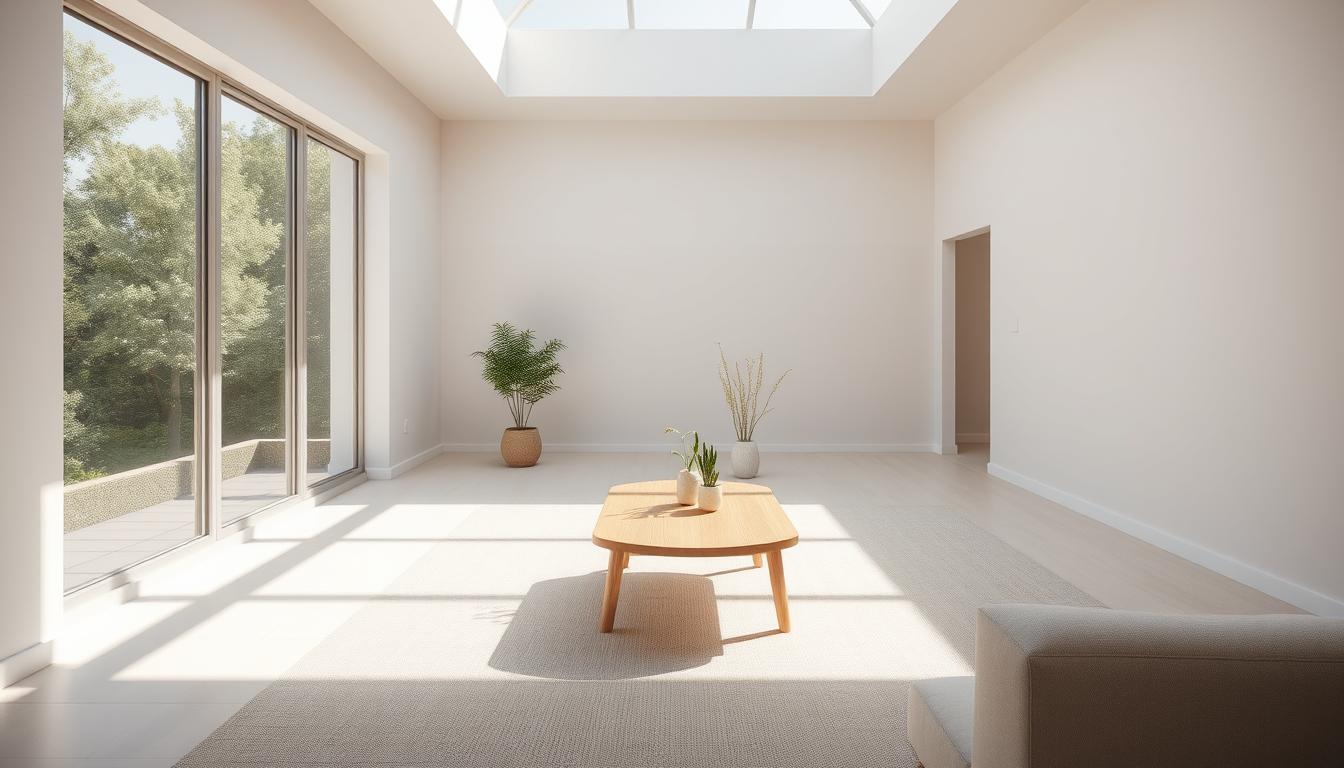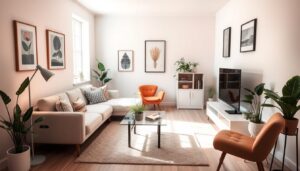In today’s world, the “capsule home” stands out as a refreshing choice. It’s all about living simply, focusing on what’s truly important. This way, homes become places of beauty, free from clutter and unnecessary stuff.
The idea of the capsule home is inspired by the “capsule wardrobe” in fashion. It’s about having a few, high-quality items that can be worn in many ways. Similarly, in a capsule home, everything is chosen carefully to fit together perfectly, creating a clean, minimalist look.
The core of the capsule home is the idea that simplicity is key. By keeping only what’s essential, homes become peaceful and organized. This approach makes homes not just look good but also feel good, helping people stay focused on what really matters.
As more people seek a simpler life, the capsule home idea is gaining traction. It’s a way to live in a space that’s both beautiful and clutter-free. By following these principles, homeowners can create a home that reflects their values and improves their life quality.
Understanding the Capsule Home Philosophy
Origins of the Capsule Concept
In the 1970s, the fashion world started talking about the capsule wardrobe. Women wanted to own fewer, better clothes. By the 1980s and 1990s, this idea grew. People wanted to live more simply and sustainably. Now, the idea of a capsule home is becoming popular too.
Core Principles of Minimalist Living
- Cultivate intentionality: Think carefully about each item in your home. Keep only what you really need or love.
- Embrace simplicity: Get rid of clutter and choose items that can do more than one thing. This makes your space more functional.
- Prioritize quality over quantity: Spend money on things that last. Choose durable, timeless pieces for your home.
Benefits of a Capsule Home Approach
Living in a capsule home has many benefits. It can make you less stressed and more productive. With fewer things, your home is easier to organize. This lets you focus on what’s important.
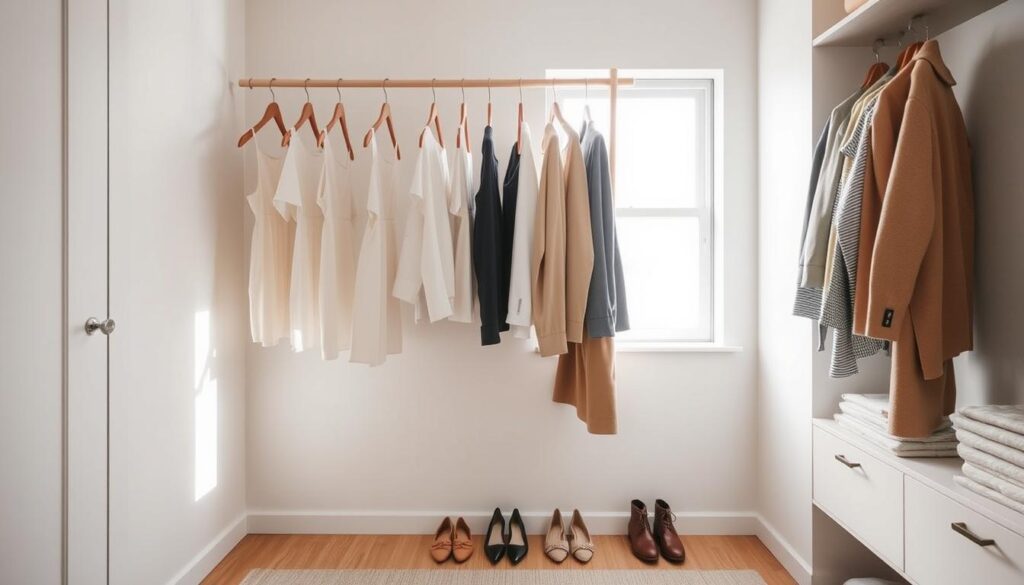
Essential Elements of Minimalist Interior Design
Creating a minimalist interior design focuses on key elements. Clean lines highlight the natural beauty of materials. A neutral color palette brings tranquility and serenity to your space.
Functional furniture is vital in minimalist interiors. Each piece must be practical and fit the design perfectly. Open spaces, free from clutter, create a calming atmosphere. This balance is what makes a minimalist interior successful.
Defining Characteristics of Minimalist Design
- Clean Lines: Minimalist design emphasizes clean, uncluttered lines that create a sense of order and visual harmony.
- Neutral Colors: A muted, neutral color palette, often featuring shades of white, gray, and beige, is a hallmark of minimalist interiors.
- Functional Furniture: Furniture in minimalist spaces is selected for its practical purpose and ability to seamlessly integrate into the overall design.
- Open Spaces: Minimalist interiors prioritize open, unobstructed spaces that promote a sense of tranquility and calm.
| Design Element | Minimalist Approach |
|---|---|
| Lines | Clean, uncluttered |
| Colors | Neutral, muted tones |
| Furniture | Functional, integrated |
| Spaces | Open, unobstructed |
By focusing on these elements, homeowners can achieve minimalist interiors. These spaces are calm, balanced, and sophisticated.
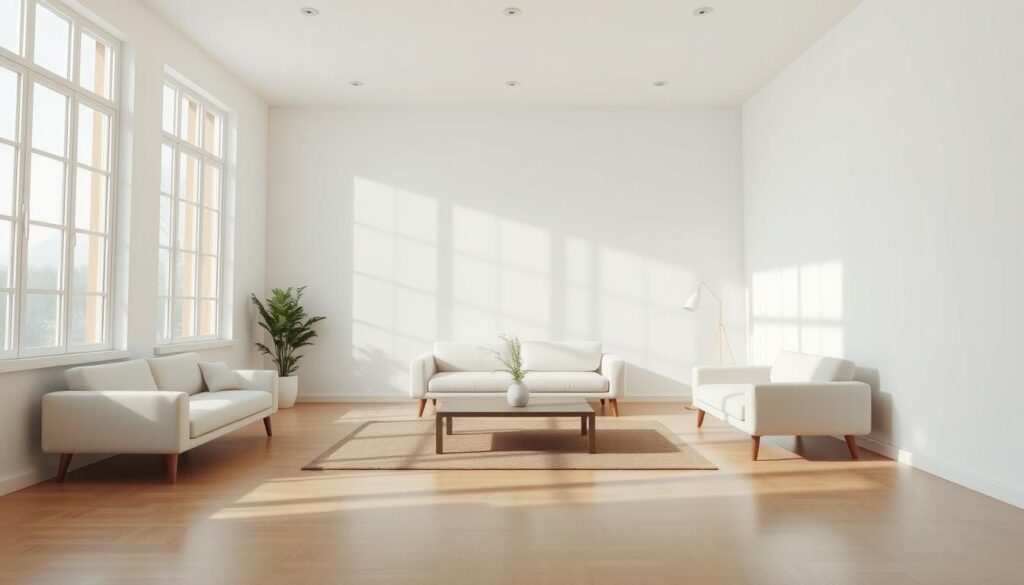
“The true essence of minimalist design lies in its ability to create a sense of tranquility and focus, allowing the beauty of simplicity to shine through.”
The Capsule Home: Applying Capsule Wardrobe Principles to Interior Design
The capsule wardrobe idea has become very popular in fashion. It changes how people think about their style. This idea can also be used in home design. It helps people create versatile decor and cohesive design in their homes.
Adapting Fashion Minimalism to Living Spaces
A capsule home uses the idea of mix-and-match furniture and timeless aesthetics. By choosing a few quality, versatile pieces, homes can look great and feel intentional. This makes decorating easier and keeps the design consistent.
Creating Versatile Room Arrangements
Applying the capsule wardrobe idea to home design means choosing furniture and decor wisely. You can make rooms flexible by picking items that do more than one thing. For example, ottomans that can be coffee tables or storage benches that offer both seating and storage. This makes it easy to change things up and keeps the space welcoming.
Maintaining Design Cohesion
To keep a capsule home looking good, pick a core color and material palette. Use textures, finishes, and colors that work well together. This creates a space that looks good without needing to change it often or getting cluttered.
By using versatile decor, cohesive design, mix-and-match furniture, and timeless aesthetics, homes can reflect personal style. It’s like having a perfectly put-together capsule wardrobe.
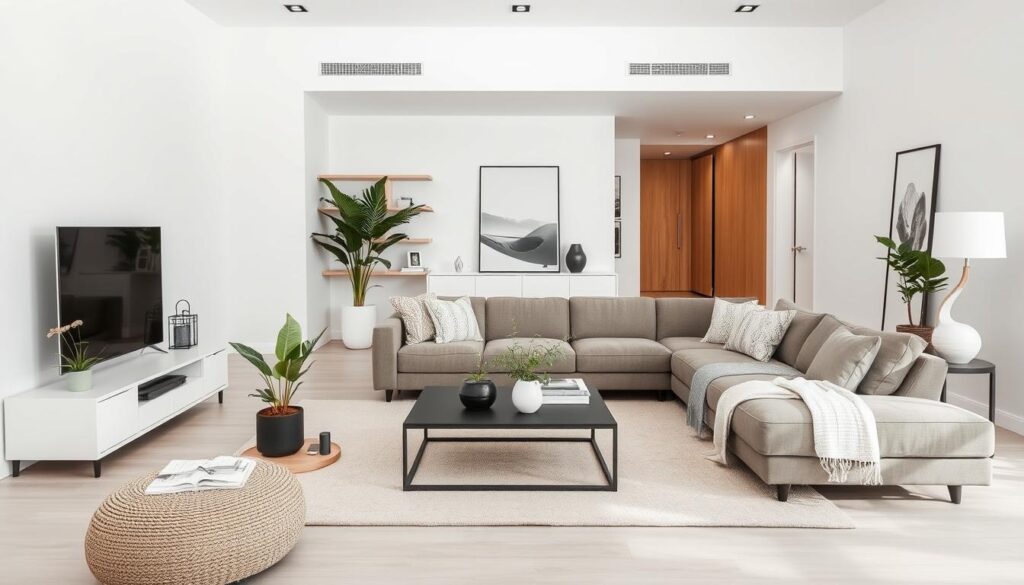
Decluttering Strategies for a Minimalist Home
For a minimalist lifestyle, decluttering is key. The KonMari method, by Marie Kondo, is a game-changer. It’s more than just cleaning up.
The KonMari method focuses on mindful consumption. It’s about keeping only what brings joy. This means thinking deeply about each item and its purpose in your life.
- Start with categories, not rooms: The KonMari method suggests tackling decluttering by category, such as clothing, books, or documents, rather than room by room. This holistic approach ensures a comprehensive purge of items that no longer serve you.
- Keep only what sparks joy: As you sort through your possessions, ask yourself, “Does this item spark joy?” If the answer is no, it’s time to let it go. This simple yet powerful question helps you identify and retain the items that truly enhance your life.
- Embrace the art of folding: The KonMari method’s signature folding techniques maximize storage space and make it easier to see and access your belongings. This organized approach to storage creates a sense of calm and control in your home.
- Declutter in a specific order: The KonMari method recommends a specific order for decluttering: clothes, books, papers, komono (miscellaneous items), and sentimental items. This sequence allows you to build momentum and make more informed decisions as you progress.
By following the KonMari method and other organization techniques, you can create a minimalist home. It’s a journey that changes your life. It may seem hard, but the results are worth it.
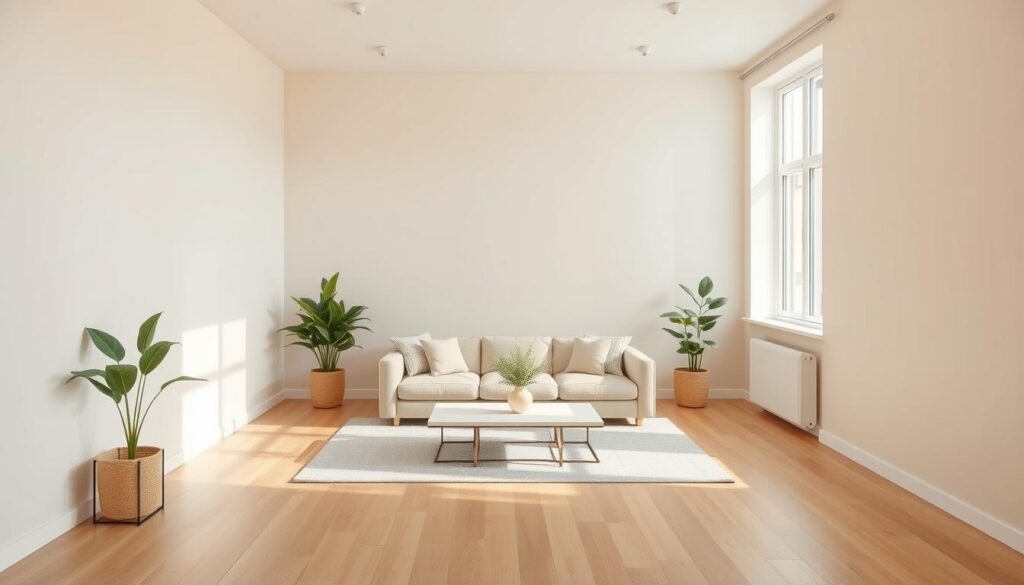
Color Theory in Capsule Home Design
Color plays a big role in creating a minimalist, capsule-inspired home. Choosing a core neutral palette and adding accent hues can make your space look and feel great. This approach brings harmony and calmness to your home.
Choosing Your Core Color Palette
The base of your home’s color scheme should be neutral. Think soft whites, grays, or beiges. These neutral base colors are calming and versatile. They let other design elements stand out.
The psychology of these neutral base colors promotes serenity and balance. These are key for a minimalist look.
Accent Colors and Their Impact
Neutral tones are the core of a capsule home. But, accent hues add interest and depth. The right accent colors can change a space’s mood and feel.
For example, earthy greens or deep blues can bring a sense of calm. Vibrant yellows or reds can add energy and excitement.
For color psychology in capsule homes, aim for visual harmony. Balance neutral foundations with accent hues. This creates a cohesive, appealing space that supports minimalist living.
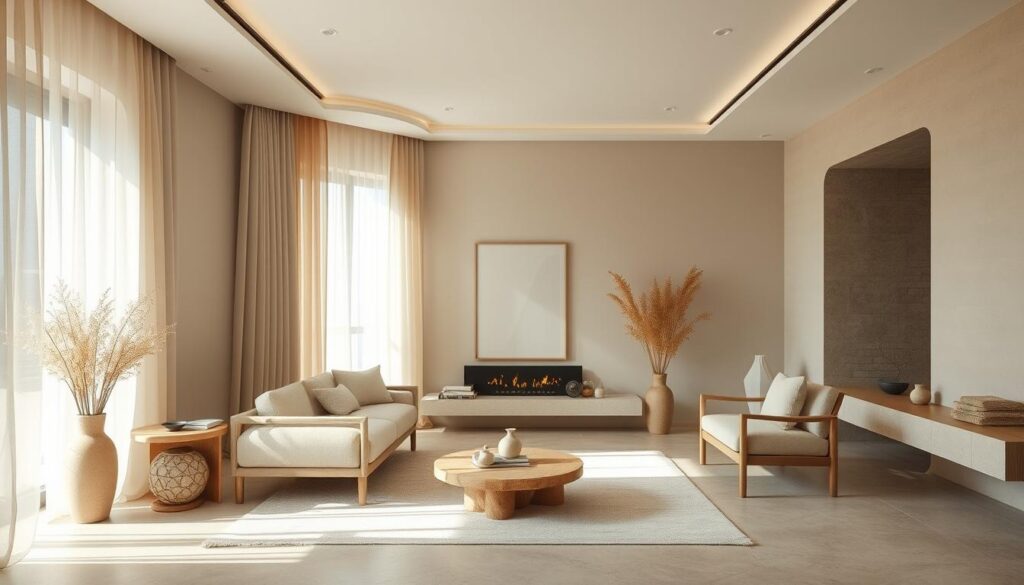
| Color | Psychological Impact | Design Application |
|---|---|---|
| White | Purity, simplicity, cleanliness | Ideal for walls, ceilings, and furniture to create a light, airy feel |
| Gray | Calm, sophisticated, timeless | Versatile neutral that can be used as a base color or accent |
| Beige | Warm, earthy, inviting | Provides a soft, natural touch to the overall design |
“Color is to the eye what music is to the ear.”
– Louis Pasteur
Furniture Selection for Minimalist Spaces
In minimalist interior design, choosing furniture is key. It helps create a space that looks good, works well, and is simple. For a capsule home, focus on quality, multi-function, and saving space.
Choosing multi-functional furniture is important. For example, a coffee table with storage or a sofa with a chaise lounge. These pieces do more in less space. Ergonomic design is also crucial. It makes sure furniture looks good and feels comfortable.
| Furniture Attribute | Importance in Minimalist Design |
|---|---|
| Multi-functionality | Maximizes utility in limited space |
| Ergonomic design | Provides comfort and supports healthy living |
| Space-saving solutions | Ensures an uncluttered, open feel |
| Quality over quantity | Invests in durable, long-lasting pieces |
For space-saving solutions, look for furniture with hidden storage. Or pieces that fold up or change shape. Choosing quality over quantity is also smart. Good furniture lasts longer and makes your space look better.
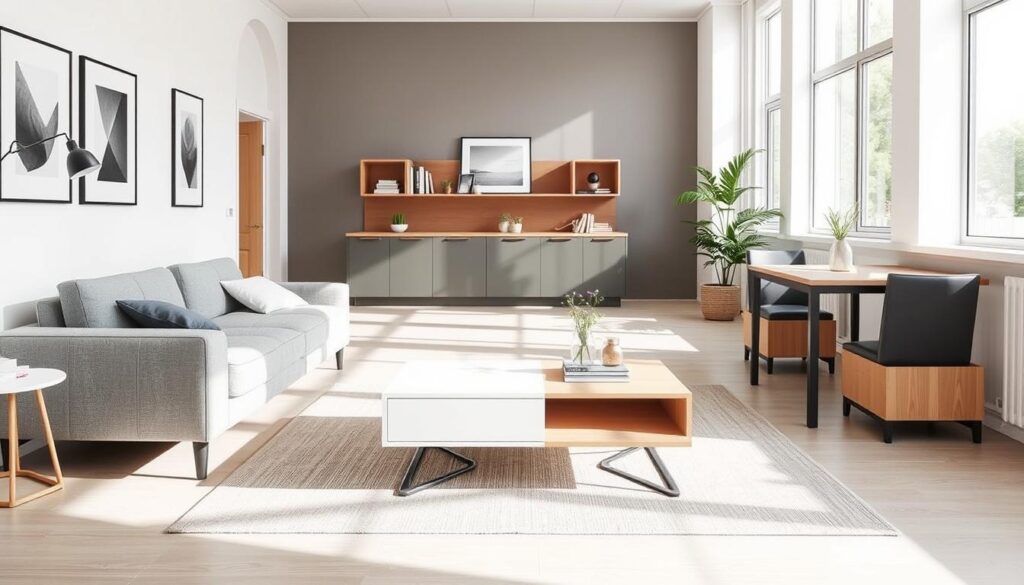
By picking furniture that follows minimalist design, you can make a beautiful, useful capsule home. It shows your style and uses space well.
Maximizing Space Through Smart Storage Solutions
In a capsule home, where less is more, smart storage is key. It keeps your space tidy and organized. By using clever hidden spots and multi-use furniture, you can make the most of your space. This creates a peaceful, simple living area.
Hidden Storage Ideas
Well-designed capsule homes often have built-in storage. You’ll find hidden shelves, secret drawers, and hidden cabinets. These spots keep your space clean and clutter-free, fitting perfectly with the capsule home style.
Multi-functional Furniture Choices
Modular and multi-use furniture are must-haves for a minimalist home. Think about ottomans with storage, beds with drawers, and tables that change. These pieces save space and keep your home tidy. They make sure every inch of your home is used well.
| Storage Solution | Benefits | Examples |
|---|---|---|
| Hidden Storage | – Conceals clutter and maintains a minimalist aesthetic – Maximizes available space – Integrates seamlessly with the overall design |
– Recessed shelving – Under-stair compartments – Concealed cabinets |
| Multi-functional Furniture | – Serves multiple purposes – Reduces the need for additional storage units – Optimizes limited space |
– Ottomans with built-in storage – Bed frames with drawers – Convertible coffee tables |
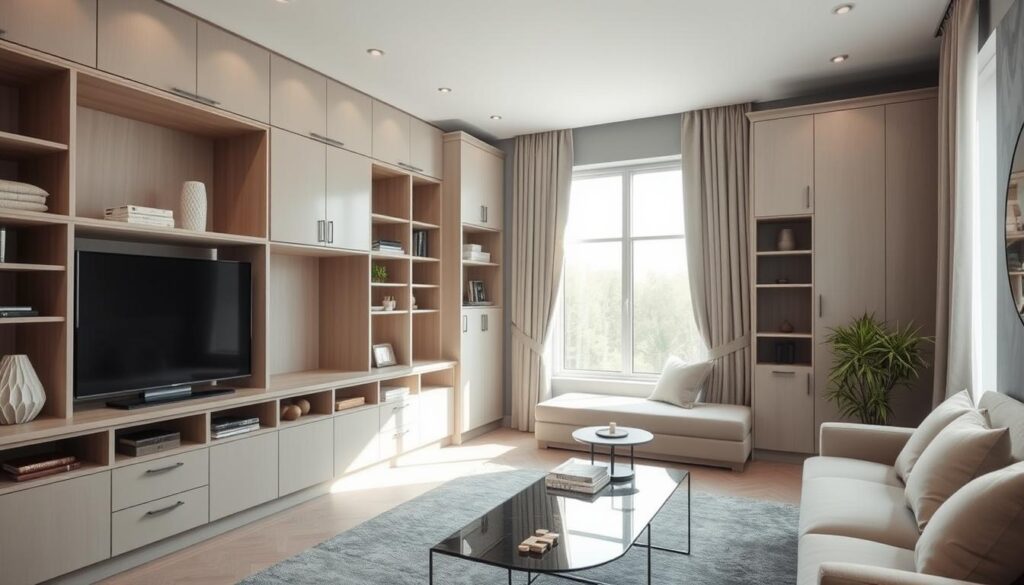
Using these smart storage ideas, you can make your home simple and clutter-free. It will use every inch of space, following the capsule home’s main ideas.
Lighting Design in Minimalist Interiors
In minimalist design, lighting is key to a cohesive and stunning space. The right mix of natural light, ambient lighting, and task lighting can turn a simple room into a peaceful retreat. Adding statement fixtures can also make your space feel like a work of art.
Using natural light is a core idea in minimalist design. By placing windows well and using sheer curtains, you can let sunlight in. This cuts down on the need for artificial light and adds warmth and energy to your home.
Ambient lighting adds a soft, even glow to your room. Floor lamps, wall sconces, and recessed lights can softly light up your space. This gentle light enhances the minimalist look.
Task lighting is crucial for activities like reading or cooking. Pendant lights over kitchen islands, desk lamps, and undercabinet lights make your home functional. They help you do your daily tasks without hassle.
Choosing the right statement fixtures can make your space stand out. A bold chandelier or a unique floor lamp can catch the eye. They add interest without losing the simplicity of your design.
By mixing natural light, ambient lighting, task lighting, and statement fixtures wisely, you can create a minimalist home that looks great and works well.
Textural Elements in Simple Design
In the quest for a minimalist look, many forget the power of touch. Tactile surfaces and contrasting textures are key to a rich, engaging space. Even in small homes, these elements can add warmth and depth beyond just looks.
Balancing Materials and Surfaces
Creating harmony in minimalist design starts with natural materials. Smooth wood, rough stone, and concrete each offer a unique feel. Mixing these textures brings visual and tactile interest to a space.
For instance, a glossy credenza paired with a soft, natural rug makes a room welcoming. A textured accent wall or a sculptural vase adds a tactile element to minimalist spaces.
Creating Visual Interest Without Clutter
The trick is to keep minimalism while using textures. Designers should pick a few key pieces that highlight material beauty. This avoids overwhelming the senses with too many textures.
By focusing on touch, designers create a space that invites deeper connection. This approach enriches the space, making it more appealing and engaging in a small home.
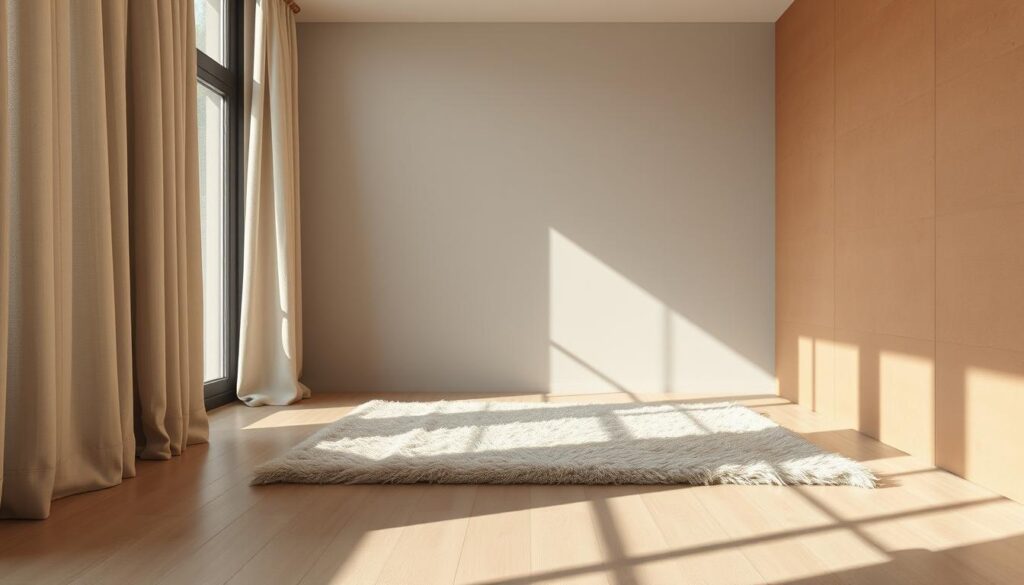
Sustainable Practices in Capsule Home Design
As we focus more on the environment, capsule home design fits right in. It uses eco-friendly materials, energy efficiency, and conscious consumption. This way, capsule homes are not just simple and useful, but also good for the planet.
Choosing the right materials is key in capsule home design. Using upcycled or recycled items adds a special touch. Plus, natural materials like bamboo and reclaimed wood make your home feel cozy and eco-friendly.
- Prioritize eco-friendly materials like bamboo, cork, and reclaimed wood
- Incorporate upcycled or recycled furnishings and decor
- Explore multi-functional, space-saving furniture to maximize efficiency
Energy efficiency is also vital in capsule home design. Smart window placement, energy-efficient lights, and high-efficiency appliances cut down energy use. This helps lower your carbon footprint.
“Sustainability is not just an aesthetic choice, but a mindset that permeates every aspect of capsule home design.”
The minimalist style of capsule living promotes conscious consumption. Homeowners choose their belongings carefully to avoid waste. This not only keeps their space tidy but also helps the environment.
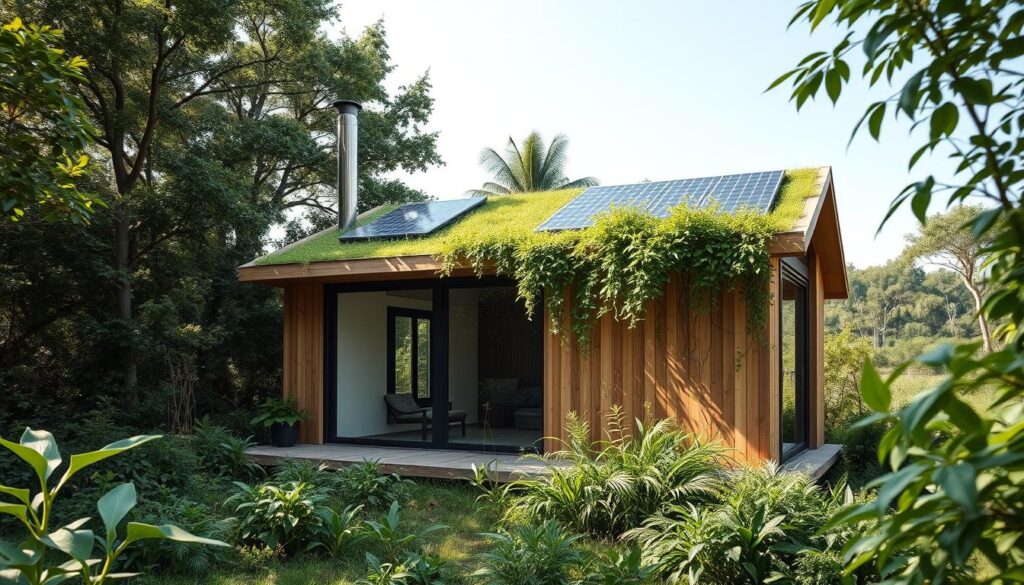
Capsule home design combines minimalism and sustainability. It creates spaces that look great and are good for the planet. By using eco-friendly materials, energy-efficient methods, and a mindful approach, capsule homeowners help make the future greener.
Seasonal Updates for Capsule Homes
Living minimally doesn’t mean your home can’t show off the seasons. With a bit of creativity and the right accessories, you can refresh your capsule home. This keeps it stylish without losing the minimalist vibe.
Transitional Decor Elements
For decor that changes with the seasons, pick items that blend in easily. Think about accent pillows, throws, and items like dried plants or vases. These add a seasonal touch without making your space feel cluttered.
Choosing the right versatile accessories lets you enjoy the look of the seasons. Yet, your home stays true to minimalist holiday decorating principles.
Maintaining Minimalist Principles Year-Round
- Swap out your decor as the seasons change. This keeps your spaces looking fresh and adaptable without adding too much.
- Go for items that do more than one thing. For example, a decorative tray that also serves food.
- Bring in natural elements. Wood, stone, or plants add warmth and texture without losing the minimalist look.
By carefully picking transitional decor and focusing on versatile accessories, you can update your home for every season. This keeps your capsule home looking great while sticking to minimalist design.
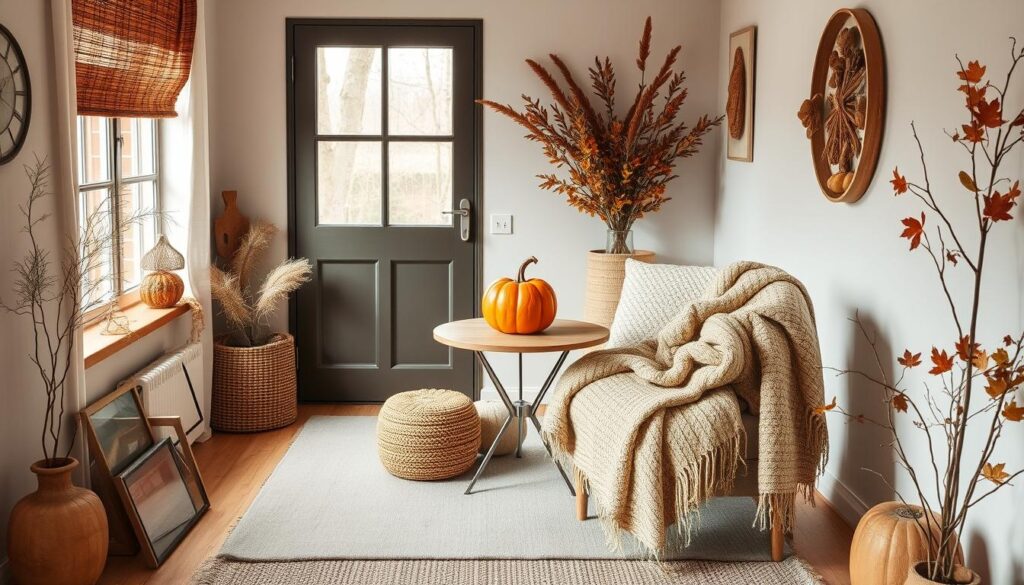
Creating Functional Zones in Open Spaces
Designing an open-plan living space can be both beautiful and practical. The secret is to create different zones for different activities. This way, you can make your space both functional and visually appealing.
Using room dividers, multi-purpose areas, and spatial planning is key. These elements help turn an open floor plan into a smooth, flow and functionality-rich area.
One good way to set up zones is with furniture. For example, a sofa and armchairs can make a cozy spot for talking. Meanwhile, a dining table and chairs can mark a place for eating. Placing these items thoughtfully helps create clear zones without losing the room’s openness.
Lighting is also important for setting up zones. Pendant lights over a dining table, floor lamps in a reading area, and recessed lights everywhere help guide the eye. Area rugs can also anchor different zones and add color and texture to the room.
| Zoning Technique | Purpose | Example |
|---|---|---|
| Furniture Placement | Establish distinct areas | Sofa and armchairs for a conversation zone, dining table and chairs for dining |
| Lighting | Highlight and differentiate zones | Pendant lights over a dining table, floor lamps in a reading nook |
| Area Rugs | Anchor and define zones | Placing a rug under a seating area to create a cozy conversation space |
By carefully using these strategies, you can make your open floor plan a harmonious and practical space. It will meet all your needs and activities.
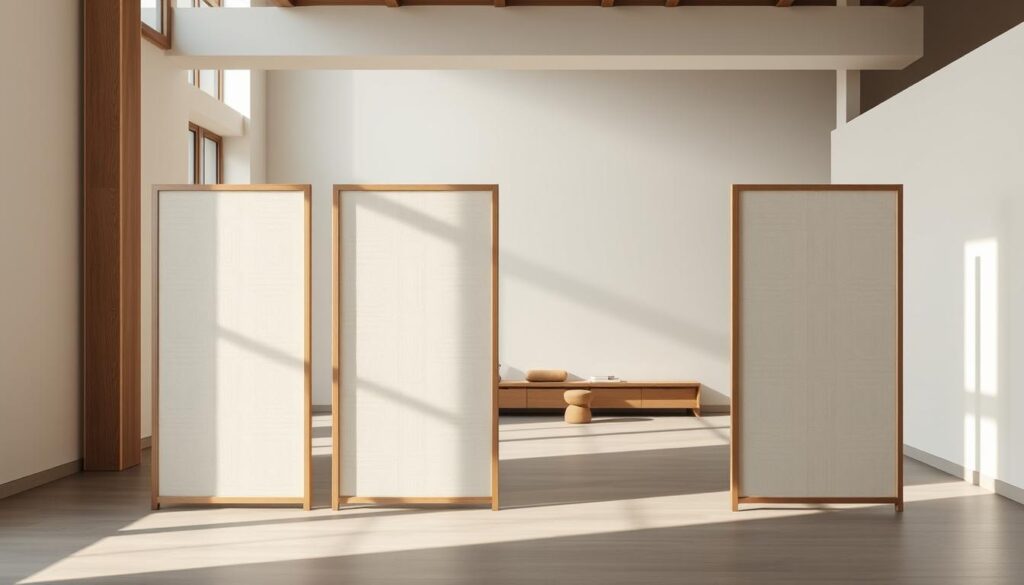
Art and Decoration in Minimalist Settings
In minimalist interior design, art and decor placement is key. It helps achieve balance and makes the space visually appealing. A well-chosen curated art collection and use of negative space can turn any room into a peaceful and eye-catching place.
Selecting Statement Pieces
In minimalist design, choosing a few focal points is important. These can be big paintings, sculptures, or unique items. They should be picked with care, as they will be the room’s highlights.
Placing these pieces thoughtfully can add interest and guide the eye. This lets negative space enhance your design’s impact.
Maintaining Visual Balance
Arranging art and decor is crucial in minimalist spaces. It’s important to plan your gallery walls carefully. This ensures each piece gets its moment, without fighting for attention.
Using negative space and curating your art well can make your minimalist space a calm and beautiful place. Every piece adds to the balance and peace of the room.

Technology Integration in Modern Minimalist Homes
Today, adding technology to minimalist homes is key. Smart home systems, hidden tech, and minimalist gadgets make homes functional yet simple. They keep the home’s look clean and uncluttered, just like the capsule home idea.
Modern minimalist design focuses on blending tech into the home. Smart home systems let you control lights, temperature, and security easily. They look clean and don’t mess up the home’s look.
Hidden tech solutions are also big in minimalist homes. You can hide tech like speakers and charging stations in furniture or walls. This makes the home look neat and tidy.
- Wireless design gets rid of ugly cords and cables. This makes minimalist spaces look even cleaner.
- Minimalist gadgets are sleek and useful. They fit well with the home’s design, adding function without ruining the look.
By mixing tech with minimalist style, homes become both beautiful and useful. They meet today’s needs while staying simple and streamlined.
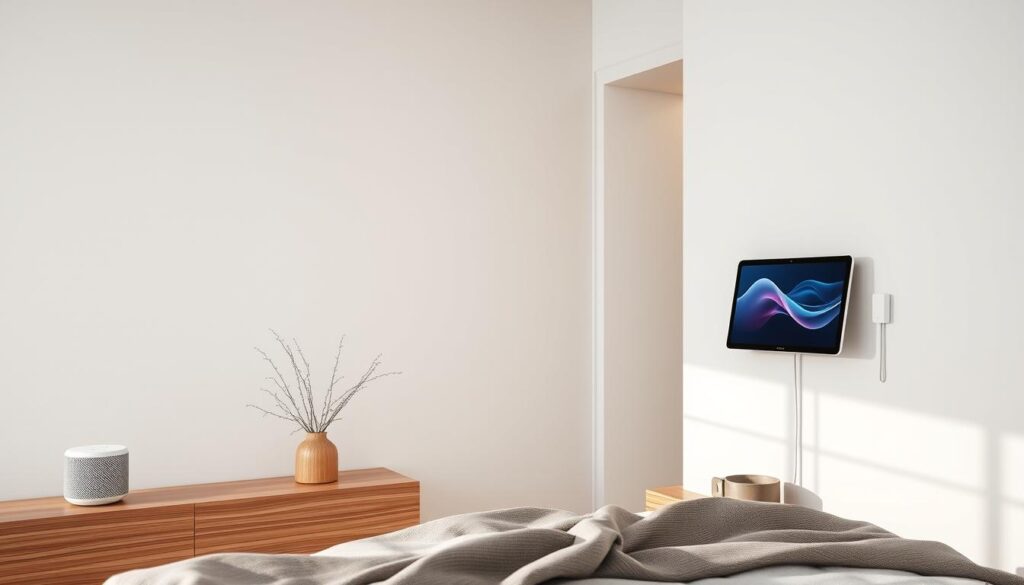
“The true essence of minimalism lies in the seamless fusion of form and function, where technology enhances the living experience without overwhelming the senses.”
Maintaining Your Capsule Home Long-Term
Living in a capsule home is a journey, not a one-time choice. It’s about building habits to keep your space simple. By buying mindfully and decluttering often, your home stays a peaceful retreat.
As your life changes, so should your home. Evolving minimalism means updating your space as needed. This might mean adding new items, changing decor, or rethinking room uses. Keeping a capsule home is a continuous effort, needing regular mindful purchases and letting go of what’s no longer needed.
Decluttering regularly is key to a well-kept capsule home. A consistent decluttering routine stops clutter from building up. It keeps your space feeling new and meaningful. Enjoy the simplicity of focusing on what truly matters to you.
Conclusion
Embracing functionality, simplicity, and purposeful living are key components of designing a capsule home. You can create an environment that is both effortlessly elegant and peaceful by focusing on timeless design, selecting quality over quantity, and curating your space with purpose. A minimalist home emphasizes your most important possessions rather than compromising your individuality. Start small, make thoughtful decisions, and see how a simplified area changes not only your house but also your attitude. Are you prepared to make your décor simpler? Start your adventure now and discover the joys of living simply.

